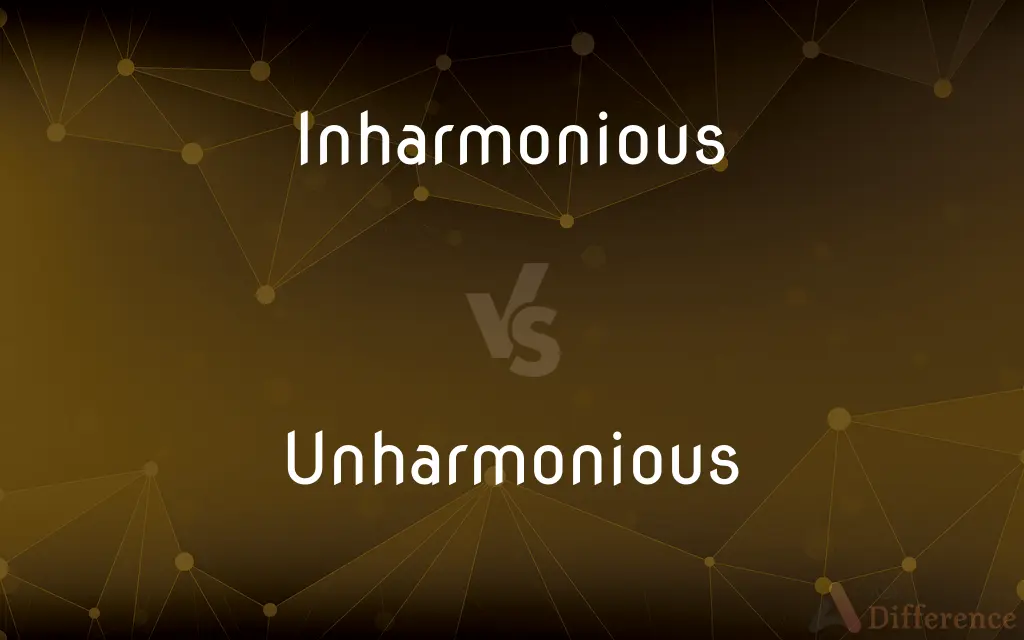Inharmonious vs. Unharmonious — What's the Difference?
By Tayyaba Rehman & Fiza Rafique — Updated on April 4, 2024
Inharmonious refers to a lack of harmony or compatibility in elements, often suggesting discordance. Unharmonious also denotes a lack of harmony, but with a broader implication of not fitting in or being out of place.

Difference Between Inharmonious and Unharmonious
Table of Contents
ADVERTISEMENT
Key Differences
Inharmonious typically describes elements within a composition or system that clash, producing a discordant effect. This term is often used in artistic or musical contexts, where the blending of notes or colors fails to create a pleasing whole. On the other hand, unharmonious can describe anything from sounds to personalities that do not blend well together, extending its usage to social and environmental contexts as well.
While inharmonious focuses on the direct conflict or discord among components, unharmonious can imply a more subtle sense of not belonging or fitting in, without necessarily causing a direct clash. For example, an unharmonious color scheme might simply be dull or ineffective rather than actively unpleasant.
Inharmonious often carries a connotation of intentional design or composition gone awry, such as in music or art where the expected harmony is disrupted. Unharmonious, however, might not imply intention and can refer to naturally occurring or unintended mismatches, like an unharmonious pairing of individuals in a team.
The term inharmonious suggests a more technical or specific disruption of what is traditionally expected to be harmonious, such as in a carefully composed piece of music. Conversely, unharmonious might be used in more general or everyday situations, describing anything from aesthetics to interpersonal relationships.
Although both terms share a root in harmony, inharmonious is more frequently used in contexts where there is a clear expectation of harmony that is not met, while unharmonious can refer to a broader range of situations where elements simply do not go well together, regardless of an expectation of harmony.
ADVERTISEMENT
Comparison Chart
Definition
Lacking harmony, often with a focus on the clash of elements.
Lacking harmony, with a broader implication of not fitting in or being out of place.
Usage Context
More common in music, art, and design.
Wider usage, including social, environmental, and personal contexts.
Implication
Suggests a direct conflict or discord among components.
Implies a subtle sense of not belonging or fitting in.
Connotation
Often implies a failed attempt at creating harmony.
Can refer to naturally occurring mismatches without intended harmony.
Expectation of Harmony
Implies a clear expectation of harmony that is not met.
May refer to situations without an explicit expectation of harmony.
Compare with Definitions
Inharmonious
Characterized by conflicting elements.
Their inharmonious relationship eventually led to separation.
Unharmonious
Lacking in harmony or agreement.
The team's unharmonious dynamics affected their performance.
Inharmonious
Lacking harmony or agreement among parts.
The inharmonious colors made the painting difficult to appreciate.
Unharmonious
Failing to create a harmonious effect.
The unharmonious use of colors in the advertisement was off-putting.
Inharmonious
Disturbing the usual or expected harmony.
The new policy was inharmonious with the company's culture.
Unharmonious
Not forming or contributing to a pleasing whole.
The unharmonious design of the building stood out awkwardly in the neighborhood.
Inharmonious
Dissonant or clashing in sound.
The inharmonious chords disrupted the melody.
Unharmonious
Not blending well with the surroundings.
The loud music was unharmonious with the quiet atmosphere of the café.
Inharmonious
Not compatible or well-suited.
His inharmonious comments during meetings often caused discomfort.
Unharmonious
Incongruous or out of place.
Her unharmonious attire made her feel self-conscious at the formal event.
Inharmonious
Not forming or contributing to a pleasing whole; discordant
An inharmonious, negative state of mind
Unharmonious
Not harmonious
The unharmonious noise of town life
Inharmonious
Not in harmony; discordant.
Unharmonious
Alternative form of inharmonious
Inharmonious
Not in accord or agreement.
Unharmonious
Inharmonious; unsymmetrical; also, unmusical; discordant.
Inharmonious
(music) Not in harmony; discordant
Unharmonious
Not in harmony
Inharmonious
Lacking accord or agreement
Inharmonious
Not harmonious; unmusical; discordant; dissonant.
Sounds inharmonious in themselves and harsh.
Inharmonious
Conflicting; jarring; not in harmony.
Inharmonious
Not in harmony
Inharmonious
Lacking in harmony of parts;
An inharmonious (or incongruous) mixture of architectural styles
Common Curiosities
Is unharmonious a negative term?
While unharmonious often has a negative connotation, it mainly highlights the absence of harmony rather than a fault per se.
How do I use inharmonious in a sentence?
You can use inharmonious to describe anything from visual and auditory elements to interpersonal relationships that clash or do not blend well.
What does inharmonious mean?
Inharmonious refers to a lack of harmony or compatibility among parts, often leading to a discordant or clashing effect.
Can a relationship be described as inharmonious?
Yes, a relationship can be described as inharmonious if it involves conflicting or clashing personalities or interests.
Is unharmonious always negative?
While typically negative, unharmonious can simply indicate a lack of fitting in or blending, without inherently implying a bad quality.
What is the difference between inharmonious and dissonant?
While both imply a lack of harmony, dissonant is more specifically used to describe clashing sounds, whereas inharmonious can refer to a broader range of conflicts.
Can music be inharmonious?
Yes, music can be described as inharmonious if its notes or rhythms clash, disrupting the intended harmony.
What does unharmonious mean?
Unharmonious describes a condition of not blending well or fitting in, without necessarily causing a direct clash.
How do inharmonious and unharmonious differ in usage?
Inharmonious is more commonly used in technical or artistic contexts to describe a failure in achieving expected harmony, while unharmonious has a broader usage, including social and environmental situations.
Can a color scheme be unharmonious?
Yes, a color scheme can be described as unharmonious if it fails to create a visually pleasing effect due to the poor combination of colors.
What makes something inharmonious?
Something becomes inharmonious when its elements clash or fail to blend, disrupting the expected harmony.
What are examples of inharmonious elements in design?
Inharmonious elements in design include clashing colors, mismatched fonts, or disproportional spacing that disrupts visual harmony.
Can an environment be unharmonious?
Yes, an environment can be described as unharmonious if its elements do not create a pleasing or cohesive whole.
Is inharmonious the same as disharmonious?
Inharmonious and disharmonious are closely related and often used interchangeably, but disharmonious might emphasize a more active state of discord.
How can I avoid creating an unharmonious effect?
To avoid creating an unharmonious effect, aim for elements that complement each other and create a cohesive and pleasing whole, whether in art, design, or social interactions.
Share Your Discovery

Previous Comparison
Yogourt vs. Yogurt
Next Comparison
Incantation vs. SpellAuthor Spotlight
Written by
Tayyaba RehmanTayyaba Rehman is a distinguished writer, currently serving as a primary contributor to askdifference.com. As a researcher in semantics and etymology, Tayyaba's passion for the complexity of languages and their distinctions has found a perfect home on the platform. Tayyaba delves into the intricacies of language, distinguishing between commonly confused words and phrases, thereby providing clarity for readers worldwide.
Co-written by
Fiza RafiqueFiza Rafique is a skilled content writer at AskDifference.com, where she meticulously refines and enhances written pieces. Drawing from her vast editorial expertise, Fiza ensures clarity, accuracy, and precision in every article. Passionate about language, she continually seeks to elevate the quality of content for readers worldwide.















































